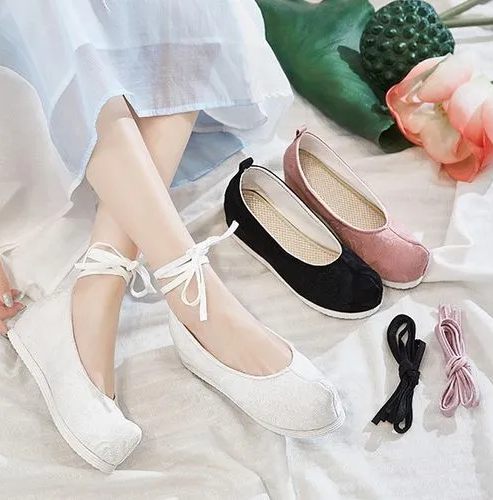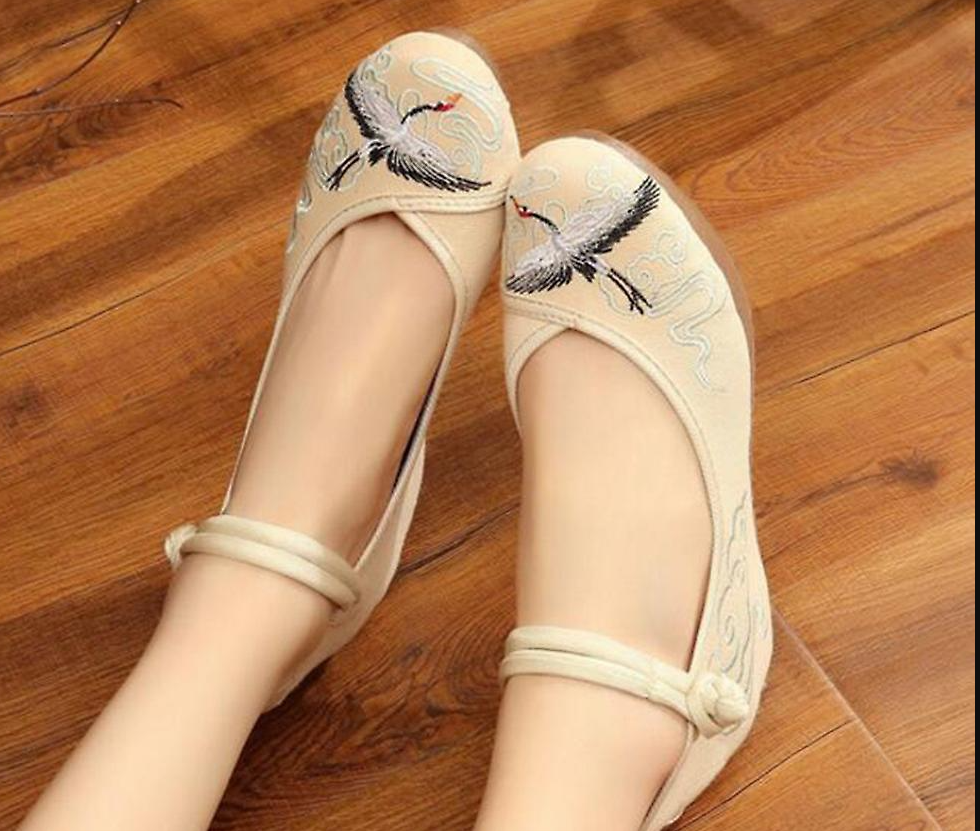Traditional options like cloth boots and Thousand-layer Sole Shoes are popular, but modern adaptations like flat shoes and loafers can also work.
Traditional Footwear Options
Cloth Boots (Bu Xie)
Cloth boots, commonly known as Bu Xie, have been a staple in Chinese traditional wear for centuries. Made primarily from fabric materials like cotton or silk, these shoes offer a comfortable yet snug fit. The design often includes intricate embroidery that complements the elegant designs of Hanfu clothing. The soles are generally soft, which makes them well-suited for indoor environments but not ideal for rugged outdoor use. You can often find a pair that matches the theme or color scheme of your Hanfu ensemble. Wikipedia: Bu Xie

Jiuyi (old-style sandals)
Jiuyi refers to the traditional Chinese sandals often worn with Hanfu. Made with woven straw or bamboo for the sole, these sandals feature tied cloth or leather straps to secure them to the feet. Ideal for warm weather, Jiuyi are considered a casual option suitable for less formal occasions. Their breathable design allows for comfortable all-day wear. The simple aesthetic matches well with lighter, summer styles of Hanfu. Wikipedia: Jiuyi
Thousand-layer Sole Shoes
A more formal and historically significant option, Thousand-layer Sole Shoes feature multi-layered soles made from cloth or leather. As the name suggests, these shoes are crafted with multiple layers, which offer a level of durability and cushioning. They are highly decorative and often feature rich embroidery and ornamental beadwork. These shoes are the go-to option for formal Hanfu attire and are especially popular for traditional ceremonies and festivities. Wikipedia: Thousand-layer Sole Shoes
Tiger-head Shoes for Children
Specifically designed for children, Tiger-head shoes are both decorative and symbolic. Typically made from cloth, these shoes are shaped like a tiger’s head, complete with embroidered eyes and a mouth. The design is believed to ward off evil spirits and bring good luck. These shoes are most commonly worn during special occasions like birthdays or traditional festivals. The vibrant, playful design complements children’s Hanfu well, adding a touch of whimsy and cultural significance. Wikipedia: Tiger-head Shoes
Modern Adaptations
Modern Hanfu Shoes
In recent years, modern adaptations of Hanfu shoes have gained popularity, especially among younger generations who want to blend tradition with contemporary fashion. These versions often utilize modern materials like rubber soles for better grip and durability. The styles also frequently incorporate zippers and Velcro straps for easy wear, while maintaining some traditional elements like embroidery or knot buttons. These shoes offer a convenient way to participate in Hanfu culture without committing to the full traditional ensemble. They can also match well with both Hanfu and modern Western clothing. Wikipedia: Modern Hanfu Movement
Stylish Options Like Flat Shoes and Loafers
Besides the traditional shoe types, you can also opt for more Western-inspired shoes like flat shoes and loafers when wearing Hanfu. These options are particularly popular for those who prioritize comfort and practicality. For example, ballet flats offer a minimalist design that can subtly complement a Hanfu outfit without overshadowing it. Loafers, on the other hand, add a touch of modern sophistication. While these options might not be historically accurate, they offer a modern twist and can be especially suitable for casual occasions. Wikipedia: Loafers
Pros and Cons of Modern Adaptations
Opting for modern adaptations of Hanfu footwear comes with its own set of advantages and drawbacks. On the plus side, modern shoes generally offer better comfort, durability, and accessibility. They are often easier to find and purchase than traditional styles. However, the downside is that they may lack the cultural and historical significance inherent in traditional Hanfu shoes. This might be a point of consideration for purists or those participating in formal, traditional events. Wikipedia: Hanfu
Factors to Consider
Seasonal Appropriate Footwear
When choosing footwear to go with your Hanfu, consider the season. During summer, breathable options like Jiuyi sandals become more popular due to their comfort and airiness. On the flip side, in winter, you may want to opt for cloth boots or Thousand-layer Sole Shoes, which provide more warmth and coverage. Some modern Hanfu shoes also feature insulating materials perfect for colder months. Make sure to also take into account the fabric and material of your Hanfu to ensure a comfortable and appropriate seasonal pairing. Wikipedia: Four Seasons in Chinese culture
Occasion (casual, formal, festive)
The occasion for which you are dressing up in Hanfu also significantly impacts your choice of footwear. For casual outings, modern adaptations or simpler traditional options like Jiuyi are ideal. For formal events, it’s best to opt for more traditional choices like Thousand-layer Sole Shoes, which often come adorned with intricate designs and embroidery. Festive occasions might allow for more ornate options, or even custom-made shoes to match the importance and theme of the event. Wikipedia: Chinese Festivals
Hanfu Style (Ming Dynasty style, Tang Dynasty style, etc.)
Different Hanfu styles, often distinguished by the dynastic periods they originated from, also dictate the choice of footwear. For example, Ming Dynasty style Hanfu often pairs well with cloth boots, whereas Tang Dynasty styles might be more open to variations like Jiuyi sandals or even modern adaptations. The key is to ensure that your shoes not only match the aesthetic but also the historical context of your Hanfu to create a harmonious ensemble. Wikipedia: Hanfu Styles
Hanfu and Footwear Pairings
Which Hanfu Styles Go Best with Which Shoes
The perfect footwear can complete your Hanfu look, but choosing the right pair often depends on the specific Hanfu style you are wearing. For Ming Dynasty styles that include intricate designs and multiple layers, cloth boots work exceptionally well. They not only complete the traditional look but also add a layer of authenticity. For Hanfu styles inspired by the Tang Dynasty, which often feature lighter fabrics and more vibrant colors, Jiuyi sandals are a popular choice, offering a relaxed yet elegant vibe. If you’re sporting a more modern or fusion Hanfu, you may find that flat shoes or loafers work best to maintain a balance between the old and the new. Wikipedia: Hanfu Styles

Illustrative Examples and Suggestions
To bring these pairings to life, consider the following examples:
- Ming Dynasty Hanfu with Cloth Boots: Imagine wearing a Ming Dynasty-inspired Hanfu that comes with elaborate patterns and embroidery. A pair of cloth boots would not only match the formality of the outfit but also keep you comfortable throughout any ceremonial or formal event.
- Tang Dynasty Hanfu with Jiuyi Sandals: Picture a flowing Tang Dynasty Hanfu with loose sleeves and vibrant floral patterns. Jiuyi sandals would complement this style perfectly, keeping the ensemble light and airy.
- Modern Hanfu with Flat Shoes or Loafers: For a modern, everyday Hanfu, you can easily pair it with flat ballet shoes or loafers. These options are not only comfortable for day-to-day wear but also keep the outfit grounded in a contemporary setting.
These examples should give you a clear idea of how to pair different types of Hanfu with appropriate footwear, elevating your ensemble while respecting its historical and cultural roots. Wikipedia: Hanfu
Footwear Customization
DIY Options for Personalizing Hanfu Shoes
For those who enjoy hands-on projects, customizing your own Hanfu shoes can be an exciting endeavor. You can start with a simple pair of cloth boots or flat shoes and add your own elements like embroidery, beadwork, or tassels. There are plenty of tutorials available online that guide you through the embroidery patterns or beadwork designs commonly found in traditional Hanfu styles. This DIY approach not only personalizes your shoes but also provides a deep sense of connection with the traditional elements of Hanfu. Wikipedia: Do It Yourself (DIY)
Online and Offline Stores Where You Can Find or Commission Custom Hanfu Shoes
If DIY isn’t your cup of tea, there are many stores both online and offline where you can find or commission custom Hanfu shoes. Websites specializing in Hanfu apparel often offer a customization service where you can choose materials, designs, and even the type of embroidery to match your outfit. Offline, artisan shops and traditional craftspeople can tailor-make shoes for you. In both cases, you have the opportunity to consult with designers or artisans to bring your vision to life, ensuring that the shoes perfectly match your Hanfu and the occasion for which you’re dressing. Wikipedia: Custom-made
Cultural Significance
The Symbolism Behind Traditional Hanfu Footwear
The choice of footwear in Hanfu culture often carries specific symbolic meanings. For instance, Thousand-layer Sole Shoes are not just a functional item but also signify social status and are considered a luxury. The layers in these shoes were initially a mark of nobility, as commoners would not have the means to afford such craftsmanship. Similarly, the embroidery designs commonly found on traditional Hanfu shoes like cloth boots can carry symbolic meanings, such as blessings for prosperity or longevity. The various patterns, knots, and color choices are not arbitrary; they have been passed down through generations and hold particular significance. Wikipedia: Chinese Symbolism
Cultural Faux Pas to Avoid
When engaging with Hanfu culture, it’s crucial to be aware of potential cultural faux pas, especially in terms of footwear. For instance, wearing casual or modern shoes with a formal Hanfu outfit for a traditional ceremony can be seen as disrespectful. Additionally, some traditional shoes like Tiger-head Shoes are specifically for children and would be considered inappropriate for adults to wear. It’s always good to research or consult with someone knowledgeable about the customs and etiquette of Hanfu culture to ensure that you are showing the proper respect and understanding. Wikipedia: Chinese Etiquette